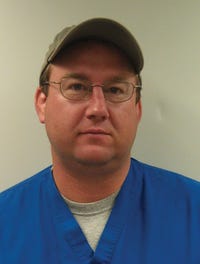Cattle health must be a priority across industry segments, but it starts at the ranch.
June 11, 2013

"Cattle that have been properly prepared for feedlot arrival simply perform better,” says Terry Engelken, DVM, Iowa State University College of Veterinary Medicine. “It doesn’t matter what parameter or benchmark you look at—feeding, animal health, or carcass. There is an extreme penalty when cattle have to be treated.”
As much as $365 per head in lost revenue can be blamed on postweaning disease.
An Iowa Tri-County Steer Carcass Futurity (TCSCF) analysis of 70,000 head fed in 21 Iowa feedlots since 2002 shows the effects of health treatments on cattle performance and profitability.
Certified Angus Beef LLC (CAB) presents the updated findings in a one-page Black Ink Basics tech sheet called “Poor calf health is a disease to profitability,” available at CABPartners.com/Educators.
“Regardless of calf ownership beyond weaning, improved health management can add value and protect profit potential,” the bulletin says, noting increased death loss and treatment accounted for up to $281.13/head in lost revenue. Reductions in performance and carcass merit reduced net return by an additional $83.88/head.
Health must be a priority across industry segments, but it starts at the ranch.

Doug Swain, DVM
Doug Swain, DVM, of the Lyman Veterinary Clinic at Griswold, Iowa, is an involved TCSCF board member. He helps set the health protocols for the feeding program, which has enrolled more than 230,000 cattle from 23 states and Canada over the last 30 years.
An underlined point in the protocols: Vaccinate at least four weeks prior to feedlot arrival. “So if you’re going to booster them after weaning, allow enough time that those shots are at least four weeks prior to delivery,” he says.
Weaning at least 30 to 45 days is a requirement of consigning cattle in the program, but Dr. Swain says weaning should not be the single workday for a set of calves.
“We need to spread stress out,” he says, referring to castrations and shots. “If we can do these things preweaning, that eliminates putting them on top of the unavoidable stress of that day.”
The vaccination program centers around two main pathogens that “cause the most trouble,” Dr. Swain says. The infectious bovine rhinotracheitis and bovine viral diarrhea modified-live injectable options deliver good protection, with the exception of syncitial virus, which “may be better delivered through a nasal vaccine.”
Enjoy what you are reading? Subscribe to Cow-Calf Weekly for more cattle health news every Friday.
Cow-calf producers who have experienced it, shudder when they hear Mycoplasma bovis, which can affect joints or respiratory function—though 10 times more likely the latter—and especially preys on those animals with underlying primary respiratory problems.
“With Myco, sometimes the best treatment, if you have a grass trap, is to just let them grow out of it,” Dr. Swain says.
Animal care continues to feedlot
To realize profits from proper preparation prior to feedlot arrival, care through the feeding phase must match it.
“If you expect your receiving program to be effective, you had better first and foremost, make sure you are taking care of the calves after they get off the truck,” Dr. Engelken explains.
Rest the cattle for a minimum of 8 hours to let them find water and feed, and a comfortable, dry place to lie down, he says. Pen conditions play a critical role in getting the cattle off to a good start. Factors such as the need for bedding or shade have to be taken into account before the cattle arrive.
Prevention is important because the more times a calf is treated, the greater the economic penalty. The data suggests treating animals two or more times reduces Prime by 30 percent and premium Choice by 36.8 percent when compared to non-treated calves.
Dr. Engelken’s research on treatment and tenderness backs this up. In a study of 350 retained ownership calves, beef from animals that remained healthy in the feedlot had a Warner-Bratzler shear force (WBSF) of 6.01 pounds. Treated calves had a WBSF of 6.47 pounds. The difference of nearly half a pound demonstrates challenged calves produced not only lower quality grades but tougher steaks.
Of course, the truth is that sometimes cattle require treatment, and in these cases maximizing first-treatment recovery rates is critical.

Terry Engelken, DVM
Dr. Engelken tells producers to “remember what your grandfather taught you.” Animal husbandry (like low stress handling and well maintained facilities) plays a huge role in how cattle respond to treatment.
He emphasizes the importance of hospital pen management, noting it should be “a place for recovery, not an overcrowded disease incubator.”
Sick and recovering cattle don’t always compete at the bunk so they need more space. He suggests at least 18 inches of linear bunk space and at least 150 square feet of pen space per head. Hospital pens should be scraped regularly and bedded as needed, and waterers washed at least twice per week.
In many cases it is advantageous to treat the cattle and send them back to their home pen, making hospital management easier since animal numbers will be much lower.
“All of these things go hand in hand to prevent disease and increase our chances of recovery,” Dr. Engelken says.
Dr. Swain also notes one area of very early prevention: selection.
“Some herds are more prone to disease because of a genetic predisposition to BRD [bovine respiratory disease],” he says. “That shouldn’t surprise us. Some lines of cattle get pinkeye more easily.”
In the future, DNA may be able to help avoid those cattle, but “in the meantime, good records can help,” he says. If a cow consistently produces chronic calves, it may signal more than coincidence.
Although some factors, like weather, are out of anyone’s control, preventing and quickly treating disease is one of the surest ways to let cattle express their full potential, the veterinarians say.
And that means more profit, along with a better cut of beef.
You might also like:
80+ Photos Of Our Favorite Calves & Cowboys
Ready For Change? New FDA Guidance Will Alter Cattle Feed Additive Usage In Your Feedyard
Tandem Evolution: BQA & Veterinarian Responsibility
You May Also Like



